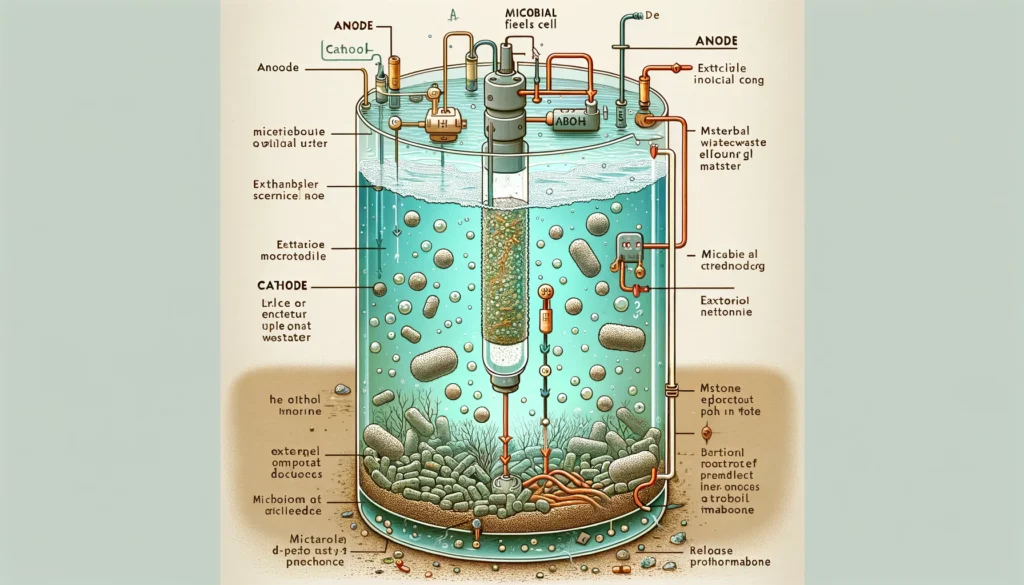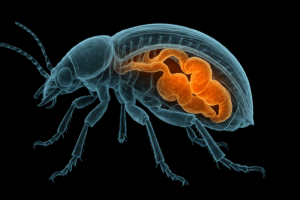Imagine a world where bacteria can power your home. It might sound like science fiction, but thanks to microbial fuel cells (MFCs), this could become a reality. Let’s dive into the fascinating world of MFCs, where tiny microbes work tirelessly to generate electricity and contribute to a sustainable future.
What are Microbial Fuel Cells?
Microbial fuel cells (MFCs) are devices that use bacteria to convert organic matter into electrical energy. Think of them as tiny power plants where microorganisms break down organic material, releasing electrons in the process. These electrons travel through a circuit, creating an electrical current.
The idea of using microbes for energy isn’t new. Scientists have been exploring this concept for decades, but recent advancements have brought MFCs closer to practical use. The key components of an MFC include an anode (where bacteria live), a cathode (where electrons flow to), and a connection between the two that allows the movement of electrons.
How Microbial Fuel Cells Work
So, how exactly do these microbial powerhouses generate electricity? It all starts at the anode, where bacteria feast on organic material like wastewater or plant matter. As they digest this material, they release electrons as a byproduct. These electrons are then transferred to the anode.

There are two main ways these electrons make their way to the anode: direct electron transfer and mediated electron transfer. In direct transfer, bacteria pass electrons directly to the anode. In mediated transfer, bacteria use chemical compounds called mediators to shuttle electrons to the anode.
Once at the anode, the electrons travel through an external circuit to the cathode, generating an electrical current. This process is continuous as long as the bacteria have a steady supply of food.
Types of Microbial Fuel Cells
MFCs come in various types, each with its unique features and applications. The two main categories are single-chamber and dual-chamber MFCs.
Single-chamber MFCs have a simpler design, with both the anode and cathode in the same chamber. This setup is easier to build and maintain but might be less efficient than dual-chamber MFCs.
Dual-chamber MFCs, on the other hand, separate the anode and cathode into different compartments. This separation can improve efficiency but adds complexity to the system. Each type has its own applications, from treating wastewater to powering small electronic devices.
Advantages of Microbial Fuel Cells
MFCs offer several exciting benefits. First, they are environmentally friendly. By using bacteria to generate electricity, MFCs provide a renewable energy source that reduces waste. Instead of relying on fossil fuels, we can harness the power of nature.
Another advantage is the potential for wastewater treatment. MFCs can clean wastewater while generating electricity, making them a double win for sustainability. They can also be scaled to fit various applications, from small household systems to large-scale industrial setups.
Compared to traditional fuel cells and other renewable energy sources, MFCs have unique advantages. They operate at lower temperatures, require less maintenance, and can utilize a wide range of organic materials.
Challenges and Limitations
Despite their promise, MFCs face several challenges. One major hurdle is efficiency. Currently, MFCs generate less power compared to other renewable energy sources. Researchers are working on improving this, but it remains a significant challenge.
Economic factors also play a role. The materials used in MFCs can be costly, and scaling up production to commercial levels is another obstacle. Additionally, maintaining the health and activity of the bacteria is crucial for continuous operation.
Current Research and Innovations
The good news is that scientists and engineers are making strides in overcoming these challenges. Recent research has led to innovations in MFC design, materials, and microbial engineering.
For instance, researchers are developing new materials for the anode and cathode to improve efficiency and reduce costs. Innovations in microbial engineering are also helping to create more robust and efficient bacterial strains.
Several pilot projects worldwide demonstrate the potential of MFCs. These projects range from treating wastewater in urban areas to providing power in remote locations. Collaboration between academia, industry, and government is crucial to advancing this technology.

Future Prospects and Potential Applications
Looking ahead, the future of MFCs is bright. With continued research and development, MFCs could become a mainstream renewable energy source. They have the potential to power homes, treat wastewater, and provide electricity in areas without access to traditional power grids.
Imagine a world where every household has an MFC system that cleans wastewater and generates electricity simultaneously. This vision isn’t far-fetched and aligns with global sustainability goals. Integrating MFCs with other renewable energy systems could create a more resilient and sustainable energy infrastructure.
Conclusion
Microbial fuel cells represent a fascinating and promising technology. By harnessing the power of bacteria, we can generate electricity in a sustainable and environmentally friendly way. While challenges remain, ongoing research and innovation are paving the way for MFCs to become a vital part of our energy future. Let’s keep an eye on this exciting field and support efforts to bring MFCs into our daily lives.
Author’s Note
Thank you for joining me on this journey into the world of microbial fuel cells. As a passionate advocate for sustainable technology, I believe in the potential of MFCs to revolutionize how we generate and use energy. Let’s stay curious and support innovative solutions for a greener future.
G.C., Ecosociosphere contributor.
Further Reading
- “Bioelectrochemical Systems: From Extracellular Electron Transfer to Biotechnological Application” by Korneel Rabaey and Lars Angenent – An in-depth exploration of the principles and applications of bioelectrochemical systems, including MFCs.





Comments
Great beat ! I would like to apprentice while you amend your web site, http://www.hairstylesvip.com how could i subscribe for a blog site? The account helped me a acceptable deal. I had been a little bit acquainted of this your broadcast provided bright clear concept
I do agree with all of the ideas you have presented in your post. They’re really convincing and will certainly work. Still, the posts are very short for starters. Could you please extend them a little from next time? Thanks for the post.
My programmer is trying to convince me to move to .net from PHP. I have always disliked the idea because of the costs. But he’s tryiong none the less. I’ve been using Movable-type on numerous websites for about a year and am anxious about switching to another platform. I have heard fantastic things about blogengine.net. Is there a way I can transfer all my wordpress posts into it? Any help would be really appreciated!